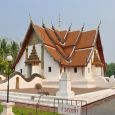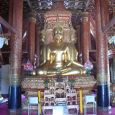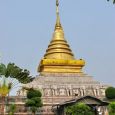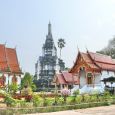Nan
Advertisement
By plane
SGA Airlines connects Nan to Chiang Mai daily.
Solar Air connects Nan to Don Muang airport in Bangkok 5 flight per week.
Happy Air connects Nan to Bangkok Suvarnaphumi airport in Bangkok 5 flight per week.
Nok Air connects Nan to Don Muang airport in Bangkok 7 flight per week.
The airport is located at the northern end of the town, on the Pua road, about 1.5 km from downtown.
By train
If you want to take train, train station that serve for Nan is Den Chai in Phrae Province. From the train station, take a sawngtaew parked in front of the station to Phrae bus station for about half an hour. And then catch a bus to Nan. There is also bus service directly to Nan from Den Chai. But you need to go to Den Chai bus station to take the bus.
By bus
The main bus station (Baw Khaw Saw) is located at the southern edge of the town, at the end of a road perpendicular (turning left when arriving from Bangkok) to the Wiangsa/Phrae/Bangkok road.
From Bangkok: Buses to/from Bangkok takes from 10 to 13 hours, according to the type of bus.
From Chiang Mai: 6 - 7 hours
From Chiang Rai: 5 - 6 hors 9:30 from the Old Bus Station in Chiang Rai - 164 Bhat - As to October 2010.
From Phrae: 2 hours
From Phitsanulok: 5 hours 11:00 and 16:30
Advertisement
The Nan National Museum
The Nan National Museum is in the original palace of the last two Feudal Lords of Nan. The building was originally constructed, in 1903 by Phra Chao Suriyapnong Phalidet, the last but one Lord of Nan to replace his former wooden residence. After the death of the Chao Maha Brahma Surathada, the last Lord of Nan, his heirs donated this palace to the government in 1931 in order to be used as the provincial hall. The museum (Th Pha Kong; admission 30B; 9AM-4PM Mon-Sat) was inaugurated in 1973 after the new provincial hall building had been erected. Thanks to relatively recent renovations, it is one of Thailand's most up-to-date provincial museums, contrary to many of them, it also has English labels for many items on display.
Wat Phra That Chae Haeng
Two kilometers past the bridge that spans the Nan River, heading southeast out of town, this temple dating from 1355 , under the reign of Pray Kan Muang, is the most sacred wat in Nan Province. It's set in a square, walled enclosure on top of a hill with a view of Nan and the valley. The Thai Lue influenced bôt features a triple-tiered roof with carved wooden eaves and dragon reliefs over the doors. A gilded Lanna-style stupa sits on a large square base next to the bôt with sides 22.5m long; the entire stupa is 55.5m high.
Wat Phra That Chang Kham
After Wat Phra That Chae Haeng, this wat is the second-most important temple (Th Pha Kong) in the city. The main vihara, reconstructed in 1458, has a huge seated Buddha image and faint murals. Also in the vihara is a set of Lanna-period scrolls inscribed (in Lanna script) not only with the usual Buddhist scriptures but also with the history, law and astrology of the time. A thammdat (a dhamma seat used by monks when teaching) sits to one side. The magnificent stupa behind the vihara dates from the 14th century, probably around the same time the temple was founded, It features 24 elephant supports similar to those seen in Sukhothai and Si Satchanalai. Next to the stupa is a small, insignificant bôt from the same era. Wat Phra That Chang Kham is also eminent by having the largest hàw trai in Thailand, but it is now empty.
Wat Hua Khuang
This small wat diagonally opposite Wat Phra That Chang Kham comprises a distinctive Lanna / Lan Xang-style stupa with four Buddha niches, a wooden hàw trai - now used as a kùti (monk cell) - and a noteworthy bòt with a Luang Prabang-style carved wooden veranda. A carved wooden ceiling and a huge naga altar can be found inside. Stylistic cues suggest this may be one of the city's oldest wats though the temple's founding date is unknown
Wat Suan Tan
Supposedly established in 1456, the Wat Suan Tan (Palm Grove Monastery; Th Suan Tan) comprises an interesting stupa of the 15th century (40 m high) which combines Hindu/Khmer style motives (stupa in form of prang) and, surmounting it, an obviously Sukhothai style motive in the shape of a lotus bud, modified in its current form in 1914. The heavily restored vihara contains the Phra Chao Thong Thipun, out of of early Sukhothai style bronze sitting Buddha in Bhûmisparsha-Mudrâ. It measures 4,10 meters and could have been ordered by the Chiangmai sovereign Tilokaraj following its conquest of Nan in 1449.
Wat Min Muang
This temple is located close to the Wat Phumin on the same side of the Th Suriyaphong, further west. Its ubosoth's exterior is embellished with elegant bas-relief stucco while its interior is adorned with mural paintings depicting Nan people's way of life, painted by present-day local artists. The Holy City Pillar is enshrined in the four-sided Thai styled pavilion in front of the ubosoth. This pillar is 3 meters high, stands on a carved gilded wooden base and is topped with a four-faced Brahma, representing the four virtues on Buddhism. It is an ancient Thai totem that is still very significant. The city pillars were probably erected as a ritual centre for agrarian fertility rites in ancient Thai towns and kingdoms, in the heart of the old cities and just next to the seat of power of a king or a chief.
Wat Phaya Phu
Located in the Th. Phaya Phu, west from the Main Police Station, this wat was built during the reign of Pra Chao Phukheng and is about six centuries old. There is a big chedi behind the vihara whare are enshrined two ancient Buddha images. The vihara's door are carved with image of mythical giant guards.
Wat Phra That Khao Noi
This wat is on the top of Khao Noi hill, two kilometers west of the town. The hill is 800 feet high. The recent temple buildings are nothing special but from the top of the hill, easily accessed by a road, one can see, side by side with a giant Buddha statue, the entire Nan town
Nan Art Gallery
Nan Art Gallery is located on Nan River, about 20 km out of the town on the road headed to Tha Wang Pha (Road No. 1080). It has many exhibition hall with temporary exhibition and souvenir shop. It can be accessed by local sawngthaew. But the most comfortable way is to drive there yourself.
October - January
Information not available
Advertisement







